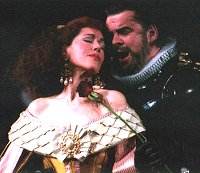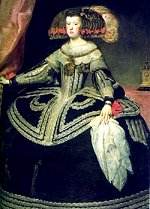We can assume that the audience of Ernani in Verdi's time would have sensed or read the subtext of this work. There was certainly apprehension that the censors would cotton on. Ernani had to be renamed variously in different locations so as not to arouse undue suspicion.It is to this production's credit to have attempted to make the subtext accessible to us through visual metaphors.
The problems of "Italia" lie in the background of this opera, although talked about at a distance through Spain. Mid 19th century authorities well understood that Ernani could be an incitement to civil disorder or revolution, a very real hazard at the time. Indeed, only four years after the first production in Venice (1844), renewed revolutionary fever swept through Europe.
This current production, first co-produced by Welsh National Opera and Royal Northern College of Music and updated under the direction of Mike Ashman, would probably have fallen foul of the censors in Verdi's time. In the very first scene we see bandits dressed in menacing black, displaying rough and testing fights between some of them. Fight director Martin McDougall made a very convincing job of it. This could be taken as an effectively realistic preparation and incitement to do battle with the established social and political order. Nowadays we might call it incitement to rioting.
The political reality was one of a meddling foreign power, the Austro-Hungarian Empire, present in parts of Italy, and a local nobility that needed to be weaned away from subservience to this status quo. A perception was current that change was possible in that age of revolutions, where the power of the common folk had been seen to be capable of achieving change. The idea of a unified and self-determining state of Italy was in the air as something that could be worked for with cultural weapons.
Sandra Ford (Elvira) and Alan Opie (Don Carlo). Photographer Bill RaffertyThe battle in Ernani is presented between the new, between Ernani the outlaw-commoner who is noble or the nobleman who is a commoner and the old man da Silva, a Grandee representing old vested local nobility interests and the King, a foreigner, who also wants possession of Elvira.
Instead of adopting name changes for the purpose of concealment, we can do the same to reveal another dimension to this opera. If we see Elvira in a metaphorical light, and substitute her name with "Italia", the whole battle for her possession and its outcome makes sense and can be seen to amount to more than the quest of three blokes to win one bird! This is not to deny the human-interest story, which this plot contains, but the use of an erotic charge for political ends is potent in this music drama. It is also stunningly realised with this production now to be seen at ENO.
Designer Maria Bjornson brought out the stultifying and stultified conventionality of the established order. The stark, dark sets, which enclose and trap Elvira (Italia) are quite claustrophobic and ask to be blown apart, especially when confronted by the evocation of a medieval and medievalist black and lightless Empire. The stupendous costume designs, re-interpreted by Irene Bohan, eloquently tell their story, and some breathtaking lighting effects by John Bishop help to bring to the surface unspoken elements of this drama.
Queen Mariana by VelasquezThe theatricality of Elvira's first appearance, framed by a doorway with brilliant blue background behind, and dressed in a Spanish court costume (made familiar and memorable through the paintings of Velasquez) speaks volumes about a body being hemmed in by a wire cage. The bold and seductive colours, the luscious fabrics and the variously and beautifully coutured dresses of her (no less wire-caged) attendants create a show meant to focus attention on surface and to divert it from unwelcome analysis. Ernani in common-sense practical garb and through identification, the audience, is meant to counter this display of power through dress.
At the end of the opera Elvira emerges as a modern woman, a real person, clothed in a softly flowing robe, urged by her self-sacrificing lover Ernani to go on living (or to start living). The King, and his eagle-helmeted equerry and the king's soldiers all appear in old-fashioned black medieval garb, with breast plates and articulated segments to their leggings - reminiscent of an army of beetles. The 19th century censors would have understood the drift of these undercurrents, especially if they, like us, had seen the Church dignitaries parade in support of the establishment.
A captivating and thoughtful presentation of Ernani; not to be missed!
Alexa Woolf
The Original Review by Duncan Hadfield
With his fifth opera, Ernani, Verdi moved away from the high-minded communal concerns of the worlds of Nabucco and I Lombardi to the more concentrated depiction of a passionate individualism; in fact, the roots of the composer's Risorgimento phase are perhaps laid here. Along with that new-found thrust for freedom there is increasing focus on the possibilities of musical characterisation; and, with three men all paying court to one woman, there are the expressive qualities of three voice types: tenor (Ernani), baritone (Don Carlos) and bass (Silva). All three certainly make the most of their voices, too, in a thrilling and high-energy account of the opera coming from ENO.
In the title role, Julian Gavin is a dashing and driven Ernani, with a resplendent tenor register - his voice also has the stamina to maintain the frenzied momentum right up to his grizzly end, and beyond. Usually seen in comic roles, Alan Opie branches into new territory, yet his delivery is no less assured, and he is on appropriately imperious form as King of Spain, Don Carlo. Meanwhile, Peter Rose's rich bass timbres make Silva into no mere gravelly old retainer; instead, he is a smooth-toned operator in more ways than one. The object of affection for the trio of male leads is the Elvira of Sandra Ford, who possesses a glittering and piercing upper register, even if her lower notes occasionally fail to register. Plus, all four principals certainly maintain the ethos of the Coliseum's opera of English policy. Anthony Peattie's translation comes over loud and clear: no surtitles required, thank you very much.
If anything, though, there are a few problems elsewhere in terms of the location of an apt dramatalurgical vehicle for the vocal pyrotechnics. Based on a High Romantic drama by Victor Hugo, Ernani is an unashamed melodrama. Three men chase one girl - Ernani seems to win, but does he? No, a pact of honour he made with the dastardly Silva entails him, rather ludicrously, instead of heading off on honeymoon after his wedding, slitting his wrists. But then this is Renaissance Spain. Or is it? Despite some colourful costumes from Irene Bohan, Mike Ashman doesn't seem able to breathe sufficient new life into reinterpreting Elijah Moshinsky's Welsh National Opera production first mounted way back in 1979. Ashman handles the crowd scenes well enough but there seems little individual psychology or motive in evidence. For all their surface vibrancy, Ernani, Carlo and Silva are cut-outs. Meanwhile, Maria Bjornsen's all-purpose black galleried set hardly conveys the necessary Act III switch of locale to some 1,500 miles north east of Iberia and the vaults enclosing Charlemagne's tomb in Aachen Cathedral - vital in terms of both the historical and 'operatic' contexts; here, Carlo is made Holy Roman Emperor and, following in the footsteps of Titus et al, dispenses forgiveness and clemency.
But if the staging is somewhat lacking in hue, the orchestral tapestry isn't. A brash and brazen approach suits the young Verdi's intentions to a tee and, in the pit, conductor David Parry gives the score some welly. But the ENO orchestra responds magnificently with great swathes of homogenous sound. Add equally sterling work from the chorus for a really gutsy musical performance all around. Nobody will be nodding off in the seat next to you at this opera.
Duncan Hadfield



 Return to:
Return to: